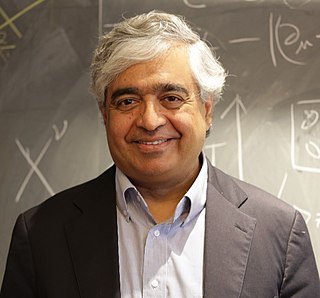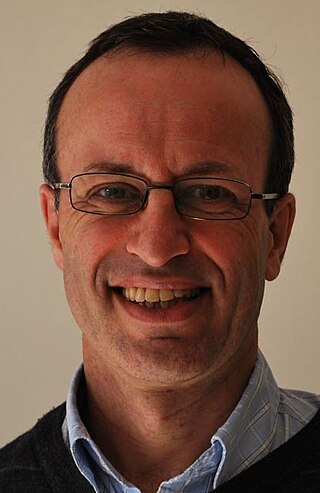Related Research Articles

Condensed matter physics is the field of physics that deals with the macroscopic and microscopic physical properties of matter, especially the solid and liquid phases, that arise from electromagnetic forces between atoms and electrons. More generally, the subject deals with condensed phases of matter: systems of many constituents with strong interactions among them. More exotic condensed phases include the superconducting phase exhibited by certain materials at extremely low cryogenic temperatures, the ferromagnetic and antiferromagnetic phases of spins on crystal lattices of atoms, the Bose–Einstein condensates found in ultracold atomic systems, and liquid crystals. Condensed matter physicists seek to understand the behavior of these phases by experiments to measure various material properties, and by applying the physical laws of quantum mechanics, electromagnetism, statistical mechanics, and other physics theories to develop mathematical models and predict the properties of extremely large groups of atoms.

Albert Fert is a French physicist and one of the discoverers of giant magnetoresistance which brought about a breakthrough in gigabyte hard disks. Currently, he is an emeritus professor at Paris-Saclay University in Orsay, scientific director of a joint laboratory between the Centre national de la recherche scientifique and Thales Group, and adjunct professor at Michigan State University. He was awarded the 2007 Nobel Prize in Physics together with Peter Grünberg.

Subir Sachdev is Herchel Smith Professor of Physics at Harvard University specializing in condensed matter. He was elected to the U.S. National Academy of Sciences in 2014, received the Lars Onsager Prize from the American Physical Society and the Dirac Medal from the ICTP in 2018, and was elected Foreign Member of the Royal Society ForMemRS in 2023. He was a co-editor of the Annual Review of Condensed Matter Physics 2017–2019, and is Editor-in-Chief of Reports on Progress in Physics 2022-.

Shoucheng Zhang was a Chinese-American physicist who was the JG Jackson and CJ Wood professor of physics at Stanford University. He was a condensed matter theorist known for his work on topological insulators, the quantum Hall effect, the quantum spin Hall effect, spintronics, and high-temperature superconductivity. According to the National Academy of Sciences:
He discovered a new state of matter called topological insulator in which electrons can conduct along the edge without dissipation, enabling a new generation of electronic devices with much lower power consumption. For this ground breaking work he received numerous international awards, including the Buckley Prize, the Dirac Medal and Prize, the Europhysics Prize, the Physics Frontiers Prize and the Benjamin Franklin Medal.

Steven T. Bramwell is a British physicist and chemist who works at the London Centre for Nanotechnology and the Department of Physics and Astronomy, University College London. He is known for his experimental discovery of spin ice with M. J. Harris and his calculation of a critical exponent observed in two-dimensional magnets with P. C. W. Holdsworth. A probability distribution for global quantities in complex systems, the "Bramwell-Holdsworth-Pinton (BHP) distribution", is named after him.
Roderich Moessner is a theoretical physicist at the Max Planck Institute for the Physics of Complex Systems in Dresden, Germany. His research interests are in condensed matter and materials physics, especially concerning new and topological forms of order, as well as the study of classical and quantum many-body dynamics in and out of equilibrium.

Laurens W. Molenkamp is a professor of physics and Chair of Experimental Physics at the University of Würzburg. He is known for his work on semiconductor structures and topological insulators.

The Laboratory of Solid State Physics (LPS) is a research institute of the Paris-Saclay University, associated to the National Center of Scientific Research (CNRS) as a joint research unit. It is located in Orsay, France, about 25 km southwest of Paris.
Ashvin Vishwanath is an Indian-American theoretical physicist known for important contributions to condensed matter physics. He is a professor of physics at Harvard University.
Claudia Felser is a German solid state chemist and materials scientist. She is currently a director of the Max Planck Institute for Chemical Physics of Solids. Felser was elected as a member into the National Academy of Engineering in 2020 for the prediction and discovery of engineered quantum materials ranging from Heusler compounds to topological insulators.

Xue Qikun is a Chinese physicist. He is a professor of Tsinghua University, Beijing. He has done much work in condensed matter physics, especially on superconductors and topological insulators. In 2013, Xue was the first to achieve the quantum anomalous Hall effect (QAHE), an unusual orderly motion of electrons in a conductor, in his laboratory at Tsinghua University. Xue is a member of the Chinese Academy of Sciences, vice president for research of Tsinghua University, and director of State Key Lab of Quantum Physics. In 2016, he was one of the first recipients of the new Chinese Future Science Prize for experimental discovery of high-temperature superconductivity at material interfaces and the QAHE. This award has been described as "China's Nobel Prize".

Thomas Maurice Rice, known professionally as Maurice Rice, was an Irish theoretical physicist specializing in condensed matter physics.
Cristiane de Morais Smith Lehner is a Brazilian theoretical physicist and professor at the Institute for Theoretical Physics at the University of Utrecht, where she leads a research group studying condensed matter physics, cold atoms and strongly-correlated systems. In 2019, the European Physical Society awarded Morais Smith its Emmy Noether Distinction.
Eugene John "Gene" Mele is a professor of physics at the University of Pennsylvania, where he researches quantum electric phenomena in condensed matter.
Shivaji Lal Sondhi is an Indian-born theoretical physicist who is currently the Wykeham Professor of Physics in the Rudolf Peierls Centre for Theoretical Physics at the University of Oxford, known for contributions to the field of quantum condensed matter. He is son of former Lok Sabha MP Manohar Lal Sondhi.
The I. I. Rabi Prize in Atomic, Molecular, and Optical Physics is given by the American Physical Society to recognize outstanding work by mid-career researchers in the field of atomic, molecular, and optical physics. The award was endowed in 1989 in honor of the physicist I. I. Rabi and has been awarded biannually since 1991.
Nai Phuan Ong is an American experimental physicist, specializing in "condensed matter physics focusing on topological insulators, Dirac/Weyl semimetals, superconductors and quantum spin liquids."
William P. Halperin is a Canadian-American physicist, academic, and researcher. He is the Orrington Lunt Professor of Physics at Northwestern University.
GrigoryEfimovich Volovik is a Russian theoretical physicist, who specializes in condensed matter physics. He is known for the Volovik effect.
References
- ↑ CMD Europysics Prize on the web page of the European Physical Society
- ↑ Europhysics Conference Abstracts. European Physical Society. 1988.
- ↑ (EPS), European Physical Society. "2020 EPS CMD Europhysics Prize - European Physical Society (EPS)". www.eps.org. Retrieved 2020-10-17.
- ↑ (EPS), European Physical Society. "2018 EPS CMD Europhysics Prize - European Physical Society (EPS)". www.eps.org. Retrieved 2018-03-09.
- ↑ (EPS), European Physical Society. "2016 EPS CMD Europhysics Prize - European Physical Society (EPS)". www.eps.org. Retrieved 2016-06-03.
- ↑ "CMD Europhysics Prize". European Physical Society. Retrieved 5 December 2014.
- ↑ Prof. Alan Tennant has won the Europhysics Prize - Projects and Awards - News - Neutronsources
- ↑ Topological quintet bags Europhysics prize - physicsworld.com
- ↑ Max Planck Institut für Festkörperforschung | Walter Metzner wins 2006 Europhysics Prize
- ↑ Albert Fert (18 September 2009). Acto de Investidura del Grado de Doctor Honoris Causa. Universidad de Zaragoza. pp. 19–. ISBN 978-84-92774-33-3.
- ↑ Mauro Dardo (14 October 2004). Nobel Laureates and Twentieth-Century Physics. Cambridge University Press. pp. 392–. ISBN 978-0-521-54008-7.